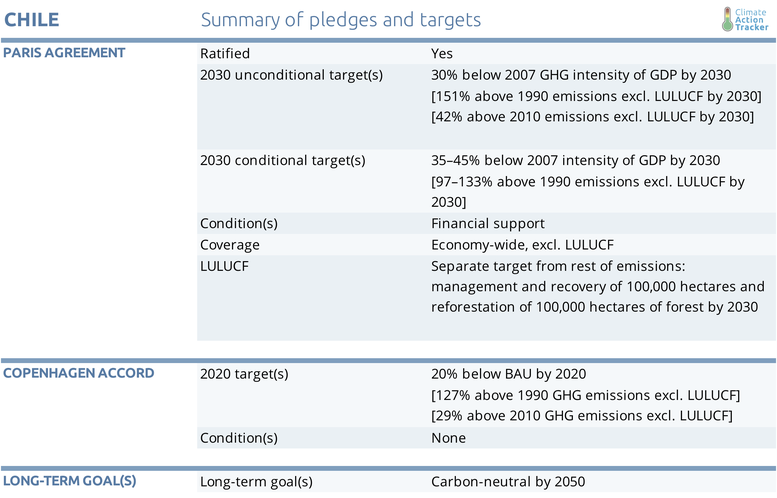Pledges And Targets
Summary Table

Paris Agreement targets
Chile’s NDC includes two emissions mitigation targets for 2030:
- Unconditional: 30% reduction of GHG emissions-intensity of GDP compared to 2007 by 2030 (Government of Chile, 2015). With an average annual projected GDP growth of 3% over the period 2017 to 2030 (Ministerio de Energía, 2017b), we estimate this option results in emissions levels of 131 MtCO2e by 2030 (152% above 1990 and 44% above 2010 GHG emissions levels excluding LULUCF).
- Conditional on international financial contributions in the form of grants: 35–45% reduction of GHG emissions-intensity of GDP compared to 2007 by 2030 (Government of Chile, 2015). We estimate this option results in emissions levels of 103–122 MtCO2e by 2030 (98–135% above 1990 and 12–33% above 2010 GHG emissions levels excluding LULUCF).
Both of the GHG emission intensity targets do not include emissions or removals from the forestry sector. In its NDC, Chile proposes separate targets to address only this sector: a) sustainable management and recovery of 100,000 hectares of forest by 2030 with estimated emissions reductions of 0.6 MtCO2e per year from 2030 and b) commitment to afforest 100,000 hectares, with mostly native species, that are estimated to capture between 0.9–1.2 MtCO2e per year from 2030 (Government of Chile, 2015). These targets are conditional on the approval of updates to the Native Forest Law and a new Forest Promotion Law, neither of which were in place as of May 2019.
2020 pledge
Chile has proposed to undertake NAMAs to reach an emissions reduction of 20% below BAU including LULUCF in 2020 (as projected from 2007). We estimate this is an absolute pledged emissions level of 122 MtCO2e in 2020 excluding emissions and sinks from LULUCF. This is equivalent to an increase of 135% from 1990 GHG emissions levels excluding LULUCF.
Further analysis
Latest publications
Stay informed
Subscribe to our newsletter




